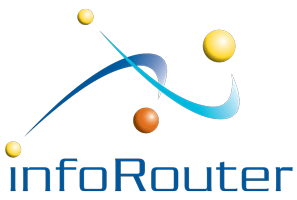Creating a folder structure for Better Organization Using Smart Folders
A well-organized folder structure doesn’t just happen—it requires careful pre-planning before you can fully leverage tools like infoRouter’s Smart Folders. Before jumping into the advanced folder management features that infoRouter offers, it’s important to sit down and map out how you want to organize your digital files.
The first step in this process is defining your top-level folders, known as infoRouter Libraries in infoRouter. These Libraries serve as isolated workspaces for teams and departments and are managed by the System Administrator or designated Library Managers. By organizing your folder structure from the top down, starting with Libraries, you can create dedicated spaces for different functions, teams, or departments.
1. Define Top-Level Libraries by Function
When planning your folder structure, the first step should be to define your Libraries by their function. Since Libraries are root-level folders in infoRouter, they should be created to reflect the broadest categories of work in your organization. For example, you may have Libraries for departments like “HR,” “Marketing,” "Sales" or “Finance,” or you could create project-specific Libraries, like “ProjectX_Development.”
Each Library is an isolated environment, meaning only its members can see or access it, which provides an additional layer of security and organization. You can assign users or user groups to each Library, ensuring that teams have access only to the Libraries they need.
2. Leverage Smart Folders for Advanced Control
Once you’ve established your top-level Libraries, you can further enhance organization within each Library by using infoRouter Smart Folders. These aren’t your typical folders—Smart Folders come equipped with customizable rules that allow you to automate certain actions, maintain security, and ensure consistency across your folder structure.
For instance, you can set rules to restrict folder creation, deletion, or document check-ins and check-outs. These rules help preserve the folder structure and maintain a secure environment, even if users have permissions to modify files. Additionally, rules can be applied to subfolders and inherited automatically, ensuring consistent control throughout the folder hierarchy.
Smart Folders also allow for configuration management, where you can limit the file types that are accepted within a folder. For example, a folder meant for artwork can be restricted to only allow graphics formats like JPEG, PSD, and PNG. Similarly, a folder dedicated to reports can be set to accept only PDFs. This ensures that the correct file formats are used, helping to maintain consistency and reducing clutter.
Once you’ve perfected the folder structure, you can lock it down by setting folder rules to disallow new folders or disallow folder deletion. This lets you maintain a stable structure while still allowing certain users "full control" rights to manage documents within the folder. These folder rules override security permissions, giving you precise control over the folder's structure while ensuring the right balance between flexibility and security.
3. Establish Consistent Naming Conventions for Folders
Having consistent naming conventions for your folders is essential for keeping your structure organized and easy to navigate. While infoRouter’s Smart Folders help manage your documents, it’s up to you and your team to establish clear and descriptive naming conventions for folders themselves.
Focus on clarity and simplicity in your folder names. Each folder should clearly describe its content or purpose, so users can easily navigate the folder system without guessing what a folder contains. For instance, use names like “2024_Project_Reports” or “HR_Employee_Contracts” rather than vague titles like “Miscellaneous” or “Docs.”
4. Keep Sub-Folder Structures Shallow for Easy Navigation
It’s tempting to create deeply nested folder structures, but this can make it harder for users to quickly locate files. Keep your sub-folder structure simple and shallow, limiting the depth to three or four levels. This ensures that documents can be accessed in just a few clicks, preventing frustration and inefficiency.
For example, within your “HR” Library, you might have subfolders for “Benefits,” “Employee Contracts,” and “Recruitment.” Further sub-folders could be created under each of these categories, but try to avoid adding too many layers to prevent overly complex navigation.
5. Use Retention and Disposition Schedules to Manage Important Documents
A critical aspect of document management is knowing how to handle both outdated documents and vital records. infoRouter’s Retention and Disposition Schedules help you stay compliant with legal and regulatory requirements by creating tasks for document retention, disposal, or protection at the appropriate time. While these schedules do prompt the right people when documents need to be archived or deleted, they also play a key role in safeguarding important documents.
Retention schedules ensure that vital records are kept for as long as necessary and prevent their accidental or unauthorized deletion. This feature is essential for managing important files that need to be preserved for legal, historical, or operational purposes, while also ensuring that unnecessary files are eventually removed to avoid clutter.
6. Folder Subscriptions for Real-Time Updates
For the control freaks out there who need absolute control over document changes, infoRouter’s Folder Subscriptions are your dream come true. With Smart Folders, you can subscribe to receive real-time notifications whenever a document is added, modified, or deleted within a specific folder. This ensures that you stay up-to-date with any changes, giving you peace of mind that no document activity happens without your knowledge.
For team members managing time-sensitive projects, these notifications are a game changer. Rather than manually checking folders for updates, they can sit back and let the notifications roll in, ensuring they’re always in the loop.
7. Organize by Date and Track Activity with Audit Trails
If your team works with time-sensitive documents like contracts or financial records, organizing by date can be an effective strategy. Smart Folders can help you track document activity through audit trails, ensuring that all changes and access events are logged. This level of tracking not only keeps your system organized but also ensures accountability for compliance and audits.
You can create subfolders by year or quarter to keep the structure clean and chronological, making it easier to locate older documents when needed.
8. Create Folder Templates for New Projects
To maintain consistency across projects, Smart Folders allow you to create reusable templates for new folders. These templates can include predefined folder structures, metadata prompts, and security rules, making it easy to ensure that every project follows the same organizational format from the beginning.
By using folder templates, you save time and reduce the likelihood of organizational issues later on, ensuring that all team members know exactly where to store their documents.
9. Review and Compact Document Versions Regularly
infoRouter’s Folder Compacting feature allows you to manage excessive document version counts. This feature is particularly useful for files that undergo multiple iterations or edits, as it consolidates versions to prevent version bloat, keeping the folder manageable without losing important information.
Compacting can be applied at the folder level, meaning you can compact all documents within a folder, ensuring that each document has a reduced version history while retaining the key versions needed for audit trails or future reference. However, compacting does not affect the overall folder structure or prevent folder clutter—it specifically targets document versions.
An additional benefit of compacting is that it speeds up search processes. When users search for “documents containing text,” each version of a document is examined. By compacting and reducing unnecessary interim versions, searches become faster, as fewer document versions need to be analyzed.
10. Personalize Folder Views for Maximum Efficiency
One of the standout features of infoRouter’s Smart Folders is their ability to remember personalization preferences, such as sorting options and view types. This means each user can configure their folders to display documents in a way that works best for them, whether it’s a list view, thumbnail view, or something more detailed.
Using folder rules, you can go a step further by configuring the default view type for specific folders. For example, if a folder contains images, you can set the default view to “Thumbnails” for a more visual display. Additionally, you can make the view type mandatory, meaning it cannot be changed by users. This ensures that folders are displayed in a consistent format, improving usability and efficiency for everyone accessing the folder.
Conclusion
infoRouter’s Smart Folders offer an advanced, customizable approach to managing your folder structure. By leveraging these features, you can ensure that your documents are organized in a way that not only makes sense for your team but also enhances security, improves workflow efficiency, and ensures compliance with company policies. Whether you’re handling sensitive information or managing complex projects, these tools will help you maintain an organized, efficient, and scalable folder system for the long term.
Take advantage of infoRouter’s Smart Folders to unlock the full potential of your document management process, making it easier than ever to stay organized and productive.
Blog Posts
- Document Management Horror Story
- infoRouter EDMS Best Practices
- Questions to Ask Before You Purchase an EDMS
- How to backup the infoRouter application directory
- How to backup the infoRouter Database
- How to backup the infoRouter Warehouse
- How to maintain the infoRouter Database
- Steps to create a great folder structure
- Supported versions and platforms

